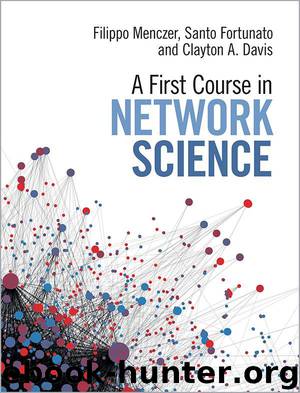A First Course in Network Science by Filippo Menczer & Santo Fortunato & Clayton A. Davis

Author:Filippo Menczer & Santo Fortunato & Clayton A. Davis [Menczer, Filippo]
Language: eng
Format: azw3, epub
Publisher: Cambridge University Press
Published: 2020-02-05T16:00:00+00:00
Fig. 5.4 Small-world networks. (a) A hexagonal lattice, a graph where each node has six neighbors (except on the boundary). There are many triangles, so nodes have a high clustering coefficient. Paths from one corner to another have to traverse many links, therefore the average shortest-path length is large. (b) Four links have been rewired to randomly selected nodes, which are typically further away from the original endpoints. These links (in red) are shortcuts, and allow us to reach remote parts of the network via a low number of hops. For instance, the shortest path from the blue node to the green node goes from 10 steps on the lattice down to six steps through one of the shortcuts. Since only a few triangles are disrupted by the rewiring procedure, the clustering coefficient remains high.
Download
A First Course in Network Science by Filippo Menczer & Santo Fortunato & Clayton A. Davis.epub
This site does not store any files on its server. We only index and link to content provided by other sites. Please contact the content providers to delete copyright contents if any and email us, we'll remove relevant links or contents immediately.
The Complete Stick Figure Physics Tutorials by Allen Sarah(7115)
Secrets of Antigravity Propulsion: Tesla, UFOs, and Classified Aerospace Technology by Ph.D. Paul A. Laviolette(4894)
Thing Explainer by Randall Munroe(3769)
The River of Consciousness by Oliver Sacks(3396)
The Order of Time by Carlo Rovelli(3063)
How To by Randall Munroe(2904)
I Live in the Future & Here's How It Works by Nick Bilton(2826)
A Brief History of Time by Stephen Hawking(2806)
What If?: Serious Scientific Answers to Absurd Hypothetical Questions by Randall Munroe(2538)
The Great Unknown by Marcus du Sautoy(2523)
Midnight in Chernobyl by Adam Higginbotham(2373)
Blockchain: Ultimate Step By Step Guide To Understanding Blockchain Technology, Bitcoin Creation, and the future of Money (Novice to Expert) by Keizer Söze(2371)
Networks: An Introduction by Newman Mark(2253)
The Meaning of it All by Richard Feynman(2204)
Easy Electronics by Charles Platt(2196)
The Tao of Physics by Fritjof Capra(2157)
Midnight in Chernobyl: The Untold Story of the World's Greatest Nuclear Disaster by Adam Higginbotham(2064)
When by Daniel H Pink(2014)
Introducing Relativity by Bruce Bassett(2008)
